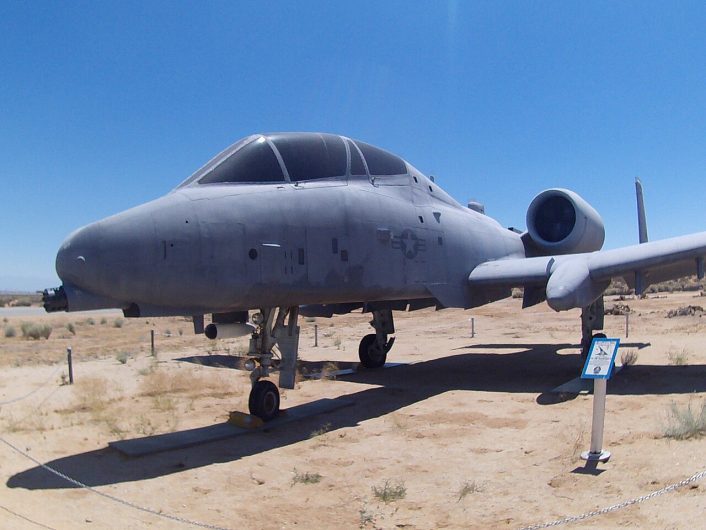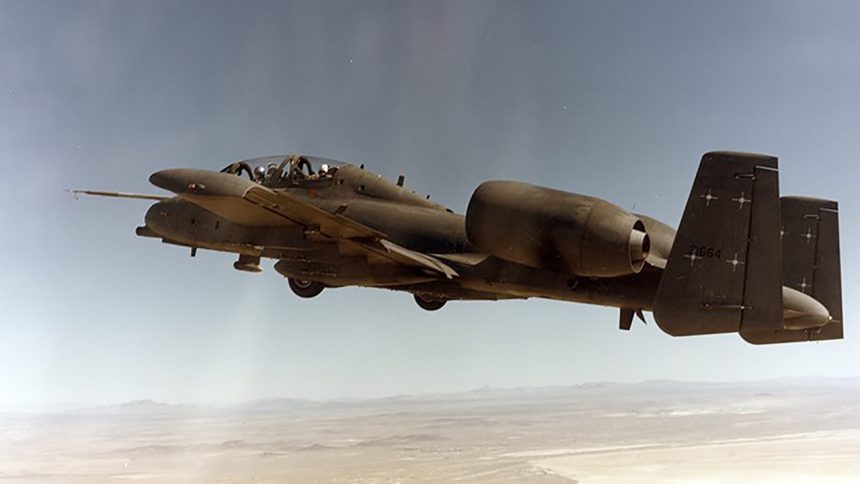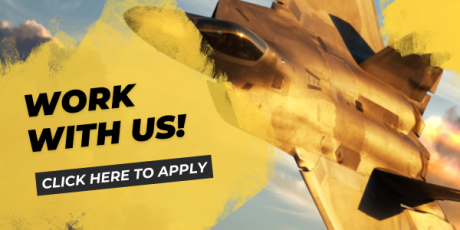Designed for all-weather, night attacks, the two-seat YA-10B was meant to counter Soviet Cold War armor tactics, but only one was built.
Project A-X
The Vietnam War had demonstrated to the United States Air Force a need for a better CAS (Close Air Support) aircraft, along with the looming threat of the growing numbers of Soviet armor. The Army had an obscure program designated the AAFSS (Advanced Aerial Fire Support System), which entailed the intention of developing a large compound helicopter to perform CAS duties. This program led to the Lockheed AH-56 Cheyenne attack helicopter.
These factors combined pressured the Air Force to initiate program A-X (Attack, Experimental) in mid-1966. Requirements would include having the endurance, weapons variety, and survivability traits similar to and superior to the aging Douglas A-1 Skyraider. Requests for proposals (RFP) went out in March 1967. Twenty-one companies were included in the initial requests, and, after a series of updated and modified RFPs, two proposals remained for consideration.
One from Northrop, designated the YA-9A, and one from Fairchild-Republic, known as the YA-10A, were accepted and two prototypes of each aircraft were ordered by the Air Force in Dec. 1970. Fairchild-Republic was eventually declared the winner on Jan. 18, 1973.
Congress demanded a fly-off between the A-7D Corsair and the A-10 before it could be built, and this took place at Fort Riley, Kansas in April 1974. The YA-10A demonstrated supremacy in the CAS mission in May and was finally allowed to be put into production. A total of six DT&E (Development, Test, and Evaluation) aircraft and four production models were initially produced and sent to Edwards Air Force Base in California.
The production A-10, known as the “Thunderbolt II” or “Warthog”, would be a single-seat heavily armed and armored ground attack aircraft. Armament consisted of the 30 mm GAU-8A Avenger seven barrel cannon with 1,150 to 1,350 rounds, and up to 16,000 lb of externally stored ordnance on ten stations. It was powered by two GE TF34-GE-100 turbofan engines giving it a speed of 368 mph, while service ceiling was 34,400 ft. The A-10 was 57 ft 6 in in wingspan and 53 ft 4 in in length, while height was 14 ft 8 in. Designed primarily for daytime operations, it could operate during darkness utilizing illumination flares, but this was less than ideal.
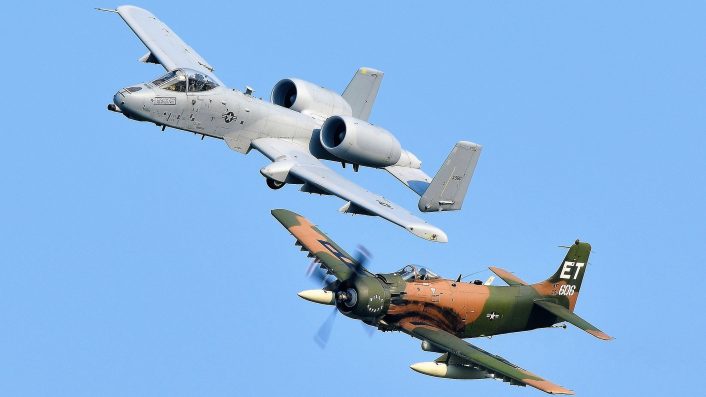
A Two-Seat Transition
From the onset of the program, plans were to allow the A-10 to be enhanced and easily developed into a two-seat variant for training, and for nocturnal and adverse weather conditions. In 1978 the Department of Defense (DOD) and Fairchild-Republic jointly funded the Night/Adverse Weather (N/AW) version development. The first YA-10 single-seat development aircraft produced, serial number 73-1664, was returned to Fairchild-Republic to create a prototype evaluation model. Since the original design allowed for expansion, reworking the airframe into a two-seat configuration would be minimal.
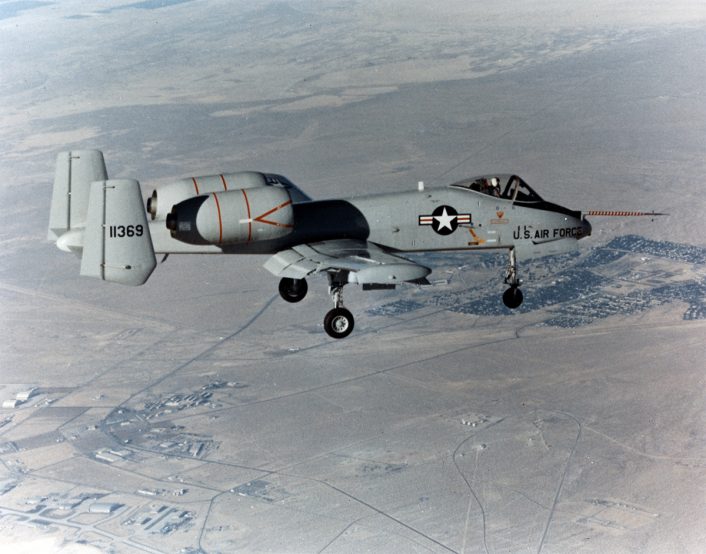
The reworking of the airframe began in April 1978, taking over a year to complete and the model being designated the A-10A N/AW. The addition of the second cockpit station added 2,000 lb to the weight of the aircraft. The Weapons System Officer would be located behind and seated slightly above the pilot, with only the pilot surrounded by the famous titanium “bathtub” armor, the WSO instead protected by side panels of an alloy/titanium/nylon composition. Avionics modules were relocated and the ammunition drum for the 30 mm cannon was reduced to 750 rounds to make room, and a newly designed side-opening canopy replaced the single-seat rear sliding type. Back-up flight controls were also added to the rear cockpit and ACES-II ejection seats were installed. To improve lateral stability and control, the fin and rudder were enlarged on the N/AW version.
Additions for nighttime and adverse weather flying included a Forward Looking Infrared (FLIR) system mounted in a pod on the centerline of the aircraft, and multimode radar in an underwing pod that included modes for target indication, ground mapping, terrain tracking, and target identification. The FLIR produced a realistic image on the Heads up Display (HUD) of the terrain, and also allowed target identification for the 30 mm cannon. The FLIR pod also contained a laser designator. A threat detector could detect radar signals from surface-to-air missile (SAM) batteries or anti-aircraft guns. An Inertial Navigation System (INS) acted as a secondary terrain avoidance monitor to the multimode radar. A pair of cathode-ray tube (CRT) displays in the rear cockpit was fed by the avionics.
Testing began on May 4, 1979, with flights at Edwards Air Force Base, California. Initial tests included checks on the controls and handling for both cockpits as well as new equipment such as low altitude sensors, with later flights evaluating flying at low altitude; target detection and using the 30 mm cannon in attacks. The pilot would carry out the gun attacks while the WSO would operate the guided weapons, and also search for second targets while the pilot attacked the first. Extensive testing on demonstrator aircraft continued into 1982, with the aircraft logging close to 300 hours.
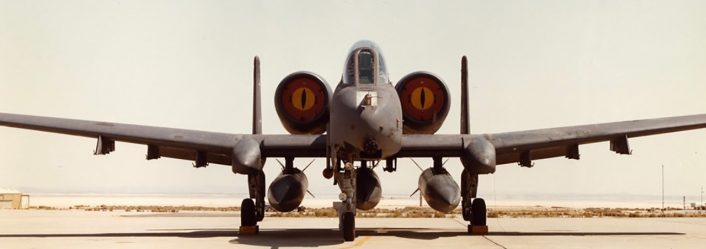
Less Costly Option
Under development was the LANTIRN (Low Altitude Navigation and Targeting Infrared for Night) system and it was due to become available in the late 1980s. The cost of converting existing A-10s to a two-seat configuration and adding the additional N/AW equipment would be around $1.5 million per plane. Another even more expensive idea was for Fairchild-Republic to build new airframes in the two-seat configuration.
However, the LANTIRN system could be adapted to existing single seat A-10 models and allowed a single pilot to do the job of two. In addition the LANTIRN could also be adapted to other aircraft such as the F-15 and F-16. The system promised advanced target recognition along with a highly advanced HUD. It allowed low altitude flying at night and all-weather while attacking targets on the ground with precision-guided weapons, just as the planned two-seat N/AW A-10, leading to the end of the two-seat program.
A two-seat trainer version of the A-10 designated the B model had also been ordered by the United States Air Force, but these were cut by congress in 1983, citing the standard A-10 was simple enough to fly and no trainer model was needed. Therefore, the single A-10A N/AW version was the only two-seat A-10 produced and became re-designated the YA-10B in the 1980’s, indicating the aircraft’s demonstration roots.
At Edwards
The first ever A-10 airframe built that became the only two-seat A-10 ever produced is still in existence and on display at the Air Force Flight Test Center Museum at Edwards Air Force Base in California. It was restored by the museum for static display in 2005, appearing on display at the 2005 Museum Open House, and is still on display there to this day.
